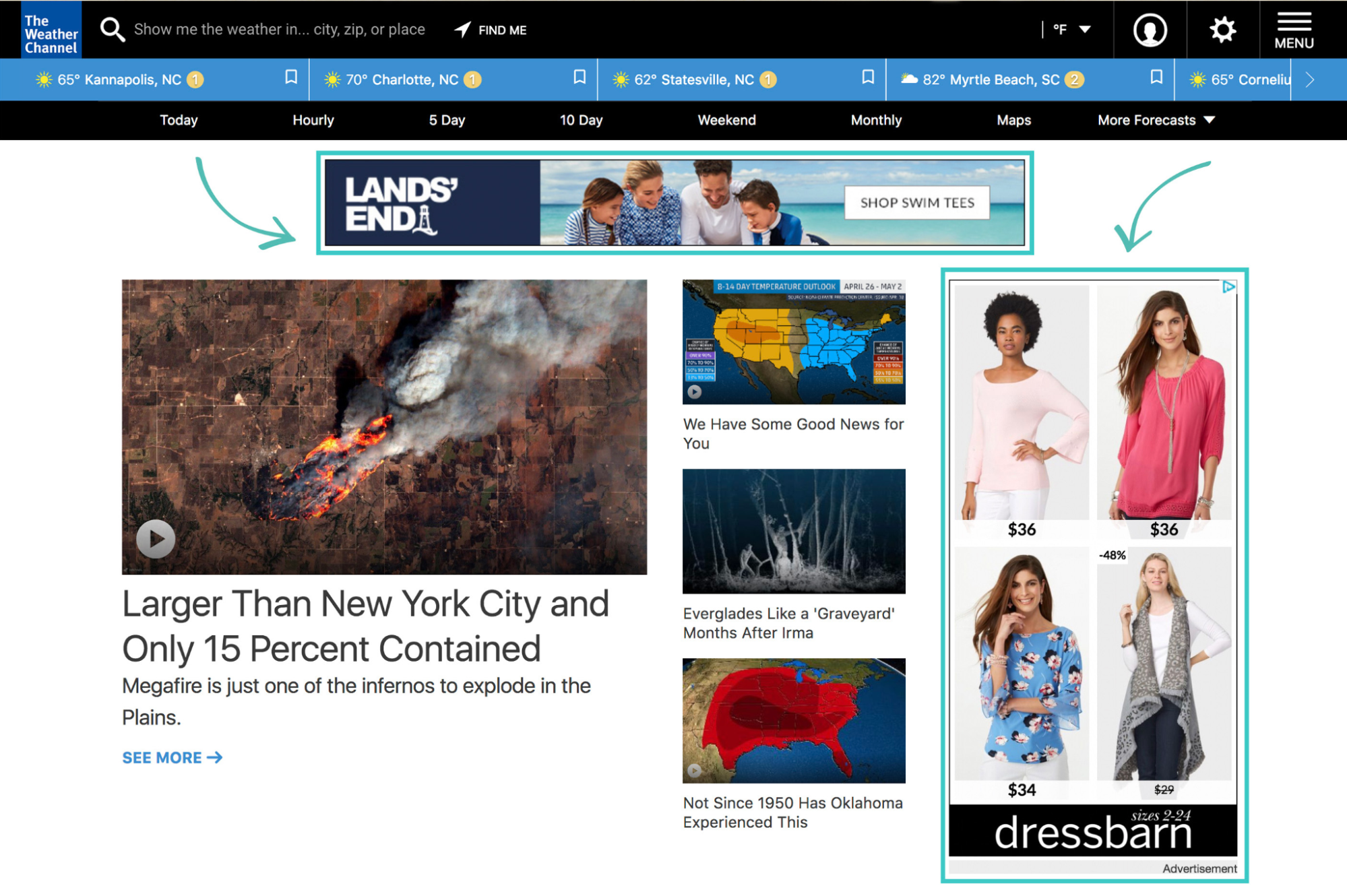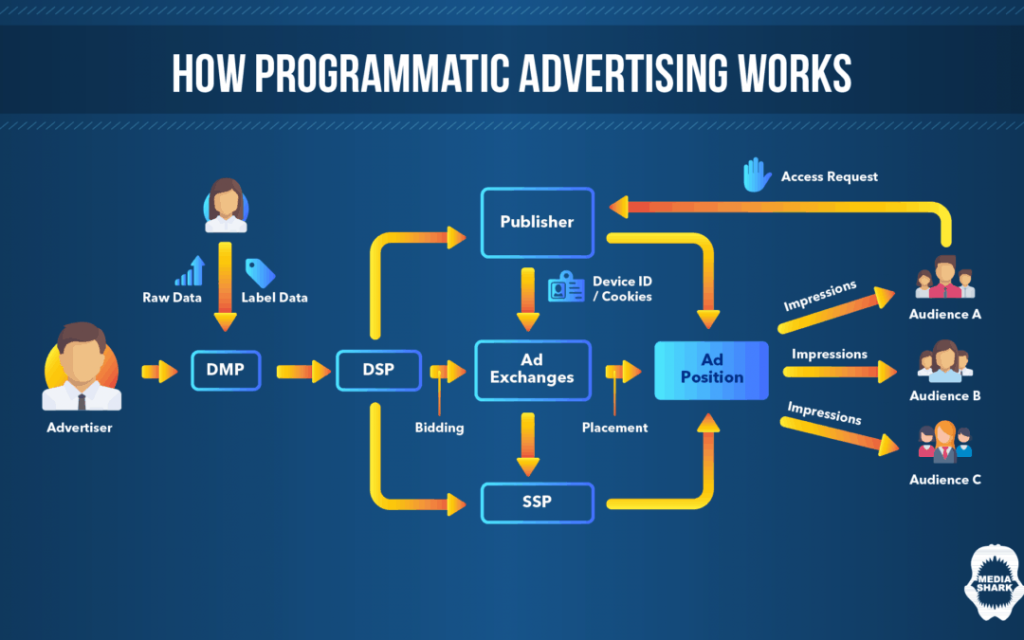Reaching and engaging the right audience is essential for success in digital marketing. But with your target audience spending more time online than ever before, traditional marketing and advertising methods often struggle to keep pace with evolving consumer behaviors.
Programmatic advertising offers a new solution for businesses and advertisers. Multichannel ads increase efficiency and cost-effectiveness and improve targeting and personalization to help companies to achieve better ROI.
This guide will help you learn the different components of artificial intelligence-powered advertising and share the numerous benefits of programmatic advertising for your brand.
What Is Programmatic Advertising?
Programmatic advertising means buying and selling digital ad space in an automated and data-driven manner. It involves utilizing algorithms, real-time bidding (RTB), and audience targeting to deliver highly personalized ads to the right audience at the right time.
You can set up an ad campaign on a demand-side platform (DSP) and specify the desired target audience parameters. As users browse various websites or apps, it will collect and analyze data in real time. When a user who matches the defined criteria visits a web page, an automated auction takes place on an ad exchange.
Advertisers bid on the available ad space, and the algorithm determines the winning bid based on relevancy, budget and targeting parameters. The winning ad is instantly delivered to the user as a tailored display or video ad.
The global programmatic advertising spend is expected to reach over $700 billion by 2026, making it one of the key digital marketing channels.
Unsurprisingly, many PPC marketers recognize the opportunity this approach to advertising provides. As a result, they report investing around 54% of their ad budget on average into programmatically purchased media.
Dive Deeper: The Ultimate Guide to Programmatic Advertising for Brands in 2023
Types of Programmatic Ads
To effectively harness the potential of this form of advertising for your business, it is crucial to have a comprehensive understanding of the primary types of programmatic ads available. These include:
1) Display Ads
These visual ads appear on websites, mobile apps or other digital platforms. Display ads can include images, videos or interactive elements, often served within banner spaces or alongside content.
Here is an example of a programmatic display ad:

2) Native Ads
Native ads blend seamlessly with the surrounding content, providing a more organic and non-intrusive user experience.
You can create ads to match the form and function of the platform on which they appear, making them less disruptive and more engaging. These ads also help to bypass ad-blocking software.
Here is an example of a native ad from Entrepreneur:

Dive Deeper: 11 Native Advertising Trends that You Can’t Ignore
3) Video Ads
Video ads are short video clips played before, during, or after online video content. These ads appear when people search for products or services that you offer and help capture audience attention at scale.
Here is an example of a video ad on YouTube:

4) Social Media Ads
Programmatic ads can also be deployed on social media platforms like Facebook, Instagram, Twitter and LinkedIn. These ads leverage the targeting capabilities of the platforms to reach specific audience segments and engage users within their social feeds.
Here is an example of a Facebook ad from 360Learning:

5) Mobile Ads
With the widespread use of mobile devices, programmatic advertising extends to mobile ads that are specifically optimized for smartphones and tablets. These ads can be displayed within mobile apps, websites, or even as in-app interstitials or rewarded videos.
Here is an example of programmatic mobile ads on Amazon:

6) Audio Ads
Programmatic audio ads are served through streaming platforms, music apps, or podcasts. They provide a targeted way to reach listeners and deliver brand messages through audio content.
Here is an example of an audio digital advertising ad on Spotify:

How Programmatic Advertising Works: Important Terms to Note
Here’s a great visual to explain how programmatic advertising works. Below, we’ll take a quick look at each of the key elements.

Demand-Side Platform (DSP)
A demand-side platform allows advertisers to manage and optimize their programmatic campaigns. The DSP provides tools for targeting specific audiences, setting bids, and tracking campaign performance.
Supply-Side Platform (SSP)
Publishers use a supply-side platform to manage and sell their ad inventory. The SSP enables publishers to make their available ad space accessible to potential advertisers through ad exchanges for an increased audience base.
Ad Exchange
An ad exchange is a digital marketplace where publishers make their ad inventory available for purchase by advertisers. It facilitates real-time bidding (RTB), where advertisers compete to display their ads to the most relevant audience.
Data Management Platform (DMP)
A data management platform collects and organizes user data, allowing advertisers to gain insights into audience behavior and preferences. DMPs help enhance potential audience targeting by leveraging real-time data to create detailed programmatic advertising audience segments.
Real-Time Bidding (RTB)
The process in which ad impressions are bought and sold in real-time auctions is known as real-time bidding. Advertisers bid on available ad inventory, and the highest bidder’s ad is displayed to the user when the webpage or app loads.
Top 6 Benefits of Programmatic Advertising
The key benefits of programmatic advertising for marketers and advertisers include the following:
1) Enhanced Efficiency
By harnessing the power of an automated algorithm, programmatic ad selection streamlines the ad buying process, reduces human error, and saves time and effort. It eliminates the need for manual negotiations and simplifies campaign management, allowing marketers to focus on strategic planning and optimization.
For example: A dried-fruit brand can leverage programmatic advertising platforms to effectively reach health-conscious individuals, fitness enthusiasts or those interested in organic food.
2) Precise Targeting
Programmatic advertising offers unparalleled targeting capabilities, enabling businesses to reach their desired audience with precision.
By utilizing comprehensive data analysis, behavioral tracking and audience segmentation, you can deliver your messages directly to the most relevant individuals, maximizing the chances of engagement and conversion.
Here are the top types of targeting available in automatic ads management:
- Demographic Targeting: It is based on demographic factors such as age, gender, income, education level, and occupation. For example, a luxury fashion brand may target buyers aged 25-45 with high-income levels.
- Behavioral Targeting: This type of targeting focuses on user behavior and interests. You can track users’ shopping behaviors and purchase history to create ads matching their interests. For instance, an outdoor gear retailer may target users who frequently visit hiking and camping websites.
- Contextual Targeting: Targets web pages or apps that are contextually relevant to the content being viewed. You can target specific keywords, topics, or categories to ensure their ads appear alongside relevant content. For example, a travel agency may target ads to appear on travel blogs, high-end lifestyle magazines, or websites featuring hotels and resorts.
- Location Targeting: This method allows advertisers to focus on specific geographical locations. Advertisers can target ads at the country, state, city or even zip code level. For instance, a restaurant chain may run programmatic advertising campaigns to users located within a certain radius of their restaurant locations.
- Weather Targeting: You can leverage weather signals in programmatic advertising to contextualize brand messaging and reach the audience in the right weather conditions. For example, a hot beverage (like tea or coffee) business can reach audiences when it’s raining.
- Device Targeting: You can target ads based on the device individuals use, such as desktop, mobile or tablet. This simple solution helps optimize ad creative and user experience for different devices. For example, a mobile app developer may target ads for mobile users to drive app installs.
- Retargeting: The digital marketing strategy to reach users who have previously interacted with their website or app. Advertisers can display retargeted ads to these users across various platforms like Google Ads and various devices to encourage them to revisit and get their preferred deal. For instance, an e-commerce retailer may show ads to users who have abandoned their shopping carts.

3) Cost-Effectiveness
One of the top benefits of programmatic advertising is that it helps to save ad dollars.
With programmatic ad management platforms, brands can directly access ad inventory and manage their campaigns, reducing the reliance on third-party entities and associated fees. This direct access gives brands more control over their ad spend, resulting in potential cost savings.
Moreover, by targeting specific audience segments and adjusting bids based on performance data, you can allocate your advertising campaign budgets more efficiently and achieve better ROI.
4) Real-Time Optimization
Programmatic advertising allows you to continuously monitor and optimize campaigns in real-time.
Leveraging an automated process, marketers can analyze performance metrics, adjust targeting parameters, and fine-tune ad creatives for increased ad effectiveness. This dynamic optimization approach ensures that digital advertising efforts stay agile and responsive to changing market conditions.
5) Enhanced Reach and Scale
By utilizing this form of advertising, businesses can tap into an extensive ecosystem of publishers, which includes major websites, news outlets, social media platforms, and niche websites.
These publishers make their media inventory available through programmatic exchanges, where advertisers can bid for and purchase ad impressions in real-time. This system gives you a vast reach across a diverse range of digital platforms, expanding your ad campaigns’ potential reach and exposure.
Therefore, programmatic media buying allows businesses like yours to tap into vast networks of media inventory across various publishers, reaching target audiences at scale.
6) Personalization and Contextual Relevance
Personalization is one of the many benefits of programmatic advertising. Programmatic ads enable personalized ad experiences with increased transparency tailored to individual users’ preferences, interests and browsing behaviors.
You can enhance engagement and drive stronger connections with your target audience by delivering relevant ads in the right context to your potential customers. This form of advertising assists in personalization by leveraging data and technology to deliver customized and relevant ads to individual users.
Creating buyer personas helps you target ideal customer groups more likely to be interested in your products or services.
Programmatic advertising can target users across multiple channels and devices, including desktop, smartphone, tablet, and connected TV. This enables you to reach users at various touch points, delivering consistent and personalized messaging across their digital journey and leveraging premium inventories.
You may also like: Content Creation for Programmatic SEO Pages
Best Practices for Running Successful Programmatic Advertising Campaigns
The best practices for creating and optimizing programmatic advertising campaigns include the following:
- Clearly define campaign objectives and key performance indicators (KPIs).
- Conduct thorough audience research and segment your target audience effectively.
- Develop compelling and engaging ad creatives that align with your brand identity.
- Implement A/B testing when running ads on a programmatic platform to optimize ad copy, visuals, and calls-to-action.
- Continuously monitor campaign performance and key metrics such as click-through rates (CTR) and conversion rates.
- Utilize real-time optimization strategies to adjust daily bidding, targeting, and creative elements for better results.
- Employ retargeting techniques to engage with users who have shown interest in your brand or products.
- Implement frequency capping to prevent ad fatigue and ensure a positive user experience.
- Ensure that your programmatic display advertising campaigns comply with data protection and privacy regulations. Invest in ad fraud prevention measures to protect your campaign budget.
- Maintain transparency and establish clear communication channels with your programmatic media partners.
- Stay updated with advertising trends and advancements to leverage new technologies and opportunities.
- Regularly review and optimize your advertising strategy to stay ahead of the competition.
- Develop meaningful and measurable programmatic advertising campaign performance reports to evaluate success and identify areas for improvement.
You may also like: Programmatic SEO for Ecommerce: Scale Your Online Store Fast
Last Word on Benefits of Programmatic Advertising
Programmatic advertising offers several key benefits to businesses seeking to maximize their digital advertising efforts. You can easily promote your brand on multiple platforms while keeping your audience’s needs in mind.
Additionally, it streamlines the ad buying process, reduces costs and provides valuable data insights for ongoing campaign refinement.
Embracing programmatic advertising empowers businesses to stay competitive in the digital landscape and unlock the full potential of their digital marketing strategies.
If you’re ready to level up your ad campaigns, Single Grain’s programmatic ads experts can help!👇



